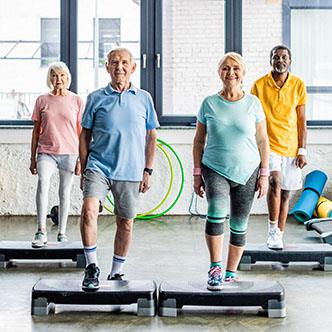
By Cole Brown; Roger S. Blumenthal, MD; Martha Gulati, MD
Every 10 years, the World Health Organization (WHO) publishes guidelines for physical activity to encourage healthy living in all countries.
Despite global efforts to emphasize the importance of exercise, the WHO has found that 1 in 4 adults and more than three-quarters of adolescents do not meet the recommendations for exercise. Also, data show no overall improvement in global levels of participation over the past two decades and lower rates of activity related to age, gender, disability, pregnancy and socioeconomic status.
The organization renewed its physical activity recommendations for 2020, which serves as a trustworthy guide for achieving a healthy style of living through physical activity. For the first time, the guidelines provide recommendations for specific populations,
such as pregnant and postpartum women, as well as people living with chronic conditions or disability.
Children and Adolescents (5-17 years)
Regular moderate physical activity in children and adolescents is associated with many positive health outcomes, such as physical fitness, blood pressure, bone health, academic performance, and mental health. Children and adolescents should do at least
an hour each day of moderate-to-vigorous intensity physical activity. They should participate in muscle- and bone-strengthening activities (such as jogging, soccer, tennis) at least three times a week.
Children and adolescents should limit their time spent sitting, particularly the amount of time spent watching television or playing video games. High amounts of sedentary behavior are associated with detrimental effects on fitness, weight gain, social
behavior, and sleep.
Adults (18-64 years)
Regular moderate physical activity in adults favorably affects all-cause mortality, cardiovascular disease, high blood pressure (hypertension), type 2 diabetes, cancer, mental health,
sleep, and weight gain. Adults should undertake 150-300 minutes of moderate-intensity or 75-150 minutes vigorous-intensity physical activity per week, or a combination of the two. Additionally, adults should complete muscle-strengthening activities
at least twice per week.
High amounts of sedentary behavior are associated with detrimental effects on mortality, cardiovascular disease, cancer, and type 2 diabetes. Adults should limit the time spent sitting and replace it with physical activity.
Older Adults (65 and above)
Regular physical activity prevents falls and declines in bone health in older adults. In addition to weekly activity, adults older than 65 should work on balance and strength training at moderate intensity at least three days a week. Older adults should limit the time spent sitting and replace it with physical activity if possible.
Pregnant and Postpartum Women
For women who are pregnant or who have recently given birth, regular physical activity benefits blood pressure and glucose, and reduces weight gain, delivery complications, postpartum depression, risk of stillbirth, and also has favorable effects on birth weight.
Women should undertake
regular physical activity before and after giving birth, including 150 minutes of moderate-intensity exercise per week as well as some muscle strengthening and stretching. Women who already participate in vigorous-intensity exercise can continue this throughout
pregnancy. Pregnant women should limit the amount of time spent sitting.
Additional safety considerations for pregnant women include:
- Avoiding physical activity during excessive heat and high humidity
- Drinking water before, during, and after exercise
- Avoiding activities that might pose a high risk of falling or that limit oxygenation (high altitude)
- Avoiding lying on their backs after the first trimester
- Talking with health care providers before participating in competitive sports
Lastly, pregnant women should talk with a health care provider about warning signs to understand when they should limit moderate physical activity.
People Living With Chronic Conditions and Disability
Physical activity is safe and provides health benefits for adults living with certain chronic conditions. The guideline looked at data for people living with cancer, high blood pressure, type 2 diabetes, and HIV. Exercise decreases the risk of death and decreases the risk of developing anxiety and depression.
Exercise is safe for individuals with disabilities, such as multiple sclerosis, spinal cord injury, intellectual disability, Parkinson’s disease, history of stroke, major clinical depression, schizophrenia, and attention deficit hyperactivity disorder (ADHD). However, some individuals might need to talk with a health care professional to decide how much and what type of activity is right for them.
Conclusion
The WHO emphasizes the health benefits of regular physical activity. It recommends reducing sedentary behavior in all age groups and demographics and incorporating muscle-strengthening activities multiple times a week. It also recommends that children and adolescents achieve an average of an hour per day of physical activity at moderate-to-vigorous intensity.
For adults each week, it recommends physical activity of 150-300 minutes at moderate intensity or 75-150 minutes at vigorous intensity. The WHO also highlights the importance of balance exercises to prevent falls.
The guidelines serve as a general overview for physical exercise in a variety of populations with recommendations for specific populations, such as pregnant and postpartum women, and people living with chronic conditions or disability.
Cole Brown is a premedical student at the University of North Carolina. Roger S. Blumenthal, MD, FACC, is Director of the Johns Hopkins Ciccarone Center for the Prevention of Cardiovascular Disease. Martha Gulati, MD, FACC, is the Editor-in-Chief of CardioSmart.
Go to CardioSmart.org/MoveMore for more information.